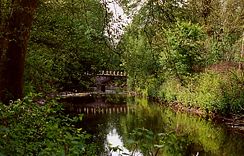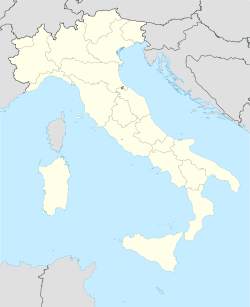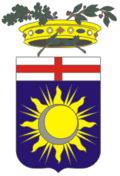Monza
| Comune di Monza | |
|---|---|
 |
|
 |
|
| Country | |
| Region | Lombardy |
| Province | Monza and Brianza (MB) |
| Mayor | Marco Maria Mariani |
| Elevation | 162 m (531 ft) |
| Area | 33.03 km² (12.8 sq mi) |
| Population (as of December 31, 2006) | |
| - Total | 121,445 |
| - Density | 3,677/km² (9,523/sq mi) |
| Time zone | CET, UTC+1 |
| Coordinates | |
| Gentilic | Monzesi |
| Dialing code | +39 039 |
| Postal code | 20052 |
| Patron | St. John the Baptist, St. Gerardo dei Tintori |
| - Day | June 24 |
| Website: www.comune.monza.mi.it | |
Monza (Munscia in Western Lombard) is a city on the river Lambro, a tributary of the Po, in the Lombardy region of Italy some 15km north-northeast of Milan. It is best known for its Grand Prix motor racing circuit, the Autodromo Nazionale Monza.
Since June 11, 2004 Monza has officially been designated the capital of the new province of Monza and Brianza. This new administrative arrangement will come fully into effect in 2009, and until then it will continue to be treated for many purposes as a comune within the province of Milan.
Monza is the third-largest city of Lombardy and the most important economic, industrial and administrative centre of the Brianza area, supporting a textile industry and a publishing trade.
Monza also hosts a Department of the University of Milan Bicocca, a Court of Justice and several offices of regional administration.
Contents |
Population
| Year | Population (Change) | Density |
|---|---|---|
| 1861 | 24.499 | - |
| 1871 | 25.266 (+767) | - |
| 1881 | 26.807 (+1,541) | - |
| 1901 | 41.218 (+14,411) | - |
| 1911 | 51.615 (+10,397) | - |
| 1921 | 54.617 (+3,003) | |
| 1931 | 61.516 (+6,899) | - |
| 1936 | 65.062 (+3,546) | - |
| 1951 | 73.114 (+8,082) | - |
| 1961 | 84.445 (+11,331) | - |
| 1971 | 114.327 (+29,882) | - |
| 1981 | 123.145 (+8,818) | - |
| 1991 | 120.651 (-2,494) | - |
| 2001 | 120.204 (-447) | - |
| December 31, 2004 | 189.263 (metro area) | - |
| December 31, 2006 | 121.445 (+1,241 or +1.03%) | 3.676,81/km² |
Climate
In 2000, the median annual temperature was 11.6°C. Its lowest winter average is 4°C, 14°C in the spring, 18.9°C in the summer and 9.7°C in the fall or autumn.
History
Origins in the Bronze Age
Late nineteenth-century finds of funerary urns show that the human presence in the area dates back at least to the Bronze Age, when people would have lived in settlements of pile dwellings raised above the rivers and marshes.
The Roman period
During the third century BCE the Romans subdued the Insubres, Gauls who had crossed the Alps and settled around Mediolanum (now Milan). A gallo-celtic tribe, who also seem to have been Insubres, then founded a village on the Lambro, of which the ruins of a bridge remain. Standing in a place where young people practised sports, the bridge was named ‘Arena’ and its remains can be seen near today’s Ponte dei Leoni (Lions Bridge).
During the Roman Empire the town was known as Modicia.
The Lombards
The Lombard invasion of Italy was an important event in Monza's history and the Lombard king Autari married Theodelinda, daughter of the Bavarian ruler Garibald I.
The new queen ordered the construction near the River Lambro of an oraculum, a sort of little church, that today is part of the basilica of Saint John. Paul the Deacon, an 8th century historian of the Lombards, tells us about this, writing: "[...] Theudelinda regina basilicam costruxerat, qui locus supra Mediolanum duodecim milibus abest, [...]" ("Theodelinda built a queen basilica, whose position is twelve miles from Milan"). There is also an important legend that Theodelinda, asleep while her husband was hunting, saw in a dream a dove who told her : "Modo", Latin for "here", in order to say that she should build the oraculum in that place, and the queen answered "etiam", meaning "yes". So from the two words "modo" and "etiam", following the legend, would have derived "Modoetia", the medieval name of Monza.
Subsequent events
In the Middle Ages, the commune of Monza was sometimes independent, sometimes subject to Milan and the Visconti.
The first rail road built in North Italy was the Milan and Monza Rail Road opened for service on August 17th,1840.
On the evening of 29 July 1900 King Umberto I of Italy was assassinated in Monza by the anarchist Gaetano Bresci.
Main sights

In the course of its history Monza withstood thirty-two sieges, but the Porta d'Agrate is all that remains of its original walls and fortifications. Nearby is the nunnery in which the nun of Monza was enclosed in Manzoni's I Promessi Sposi.
Monza is famous for its Romanesque-Gothic Duomo of Saint John. There Theodelinda's centrally-planned Greek-cross oraculum ("chapel of prayer") of ca 595 (its foundations remaining under the crossing of nave and transept) was enlarged at the close of the 13th century by enclosing the former atrium within the building. The fine black and-white marble arcaded facade was erected in the mid-14th century by Matteo da Campione. The campanile was erected in 1606 to designs by Pellegrino Tibaldi. In the frescoed Chapel of Theodelinda is the Iron Crown of Lombardy, supposed to contain one of the nails used at the Crucifixion. The treasury also contains the crown, fan and gold comb of Theodelinda, and, as well as Gothic crosses and reliquaries, a golden hen and seven chickens, representing Lombardy and her seven provinces. Though the interior has suffered changes, there is a fine relief by Matteo da Campione representing a royal Lombard coronation, and some 15th-century frescoes with scenes from the life of Theodelinda.
The historical centre also contains the church of Santa Maria in Strada, with a rich terra-cotta facade of 1393, and the Broletto or Arengario, the 14th-century palace of the civic commune, raised on an arcade of pointed arches, with a tall square machiolated tower terminating in a sharp central cone.
Nearby, the royal villa (Villa Reale) originally built by Piermarini in 1777 for the archduke Ferdinand of Austria, lies on the banks of the Lambro, surrounded by its park, one of the largest enclosed parks in Europe.
Other villas includes the Mirabello, Mirabellino, Durini, Crivelli Mesmer, Prata, Archinto Pennati, Calloni and Carminati.
Theatres and cinemas
- Teatro Manzoni (Manzoni Theatre)
- Teatro Villoresi (Villoresi Theatre)
- Teatro Binario 7 (Binario 7 Theatre)
- Sala San Carlo
- AreaOdeon
Sport
Monza is known internationally for the Autodromo Nazionale Monza motor racing circuit, home to the Italian Grand Prix, and previously to the Alfa Romeo team. The circuit is inside the "Parco di Monza", a park that is double the size of New York's Central Park.
Monza is also known for the "Villa Reale", a Habsburg family residence built in 1777.
The professional football club A.C. Monza Brianza 1912 play, currently in Serie C1, at the Stadio Brianteo.
In 2006 Monza hosted the World Cyber Games tournament.
In 2005, July, Monza hosted the "International Gran Galà Marching Show Bands" at Stadio Brianteo (with the USA band Blue Devils, 11 times WMSB Champion of the World). They will be hosting this event again in July of 2008.
Transportation
Monza can be reached through the following motorways: A4-E64 (Turin-Milan-Venice), A52 (North Ring of Milan), A51 (East Ring of Milan). State road (SS.36 - Nuova Valassina) connect the city to Lecco and Sondrio. A 2 km long tunnel will be added by around September 2011 and will alleviate traffic problems that are happening in the city.
Every few minutes, trains travel between Monza and Milano via the Suburban Railway (Line S9) and via local trains that connected Monza to Lecco, Como/Chiasso (CH) and Bergamo/Brescia. Also some Eurocity trains stop in Monza. In the beginning of 2008 work will be started for the expansion of Subway Line MM1 from Milano/Sesto San Giovanni to Monza Bettola.
Notable people
- Theodelinda, queen of Lombardy
- Carlo Amati (1776-1852), architect
- Emilio Borsa (1857-1931), painter
- Gerolamo Gaslini (1877-1964), olear industrialist and philanthropists
- Vittorio Brambilla (1937-2001), F1 racer
- Daniele Massaro (1961), footballer (soccer player)
External links
|
|||||||||
|
|||||||

